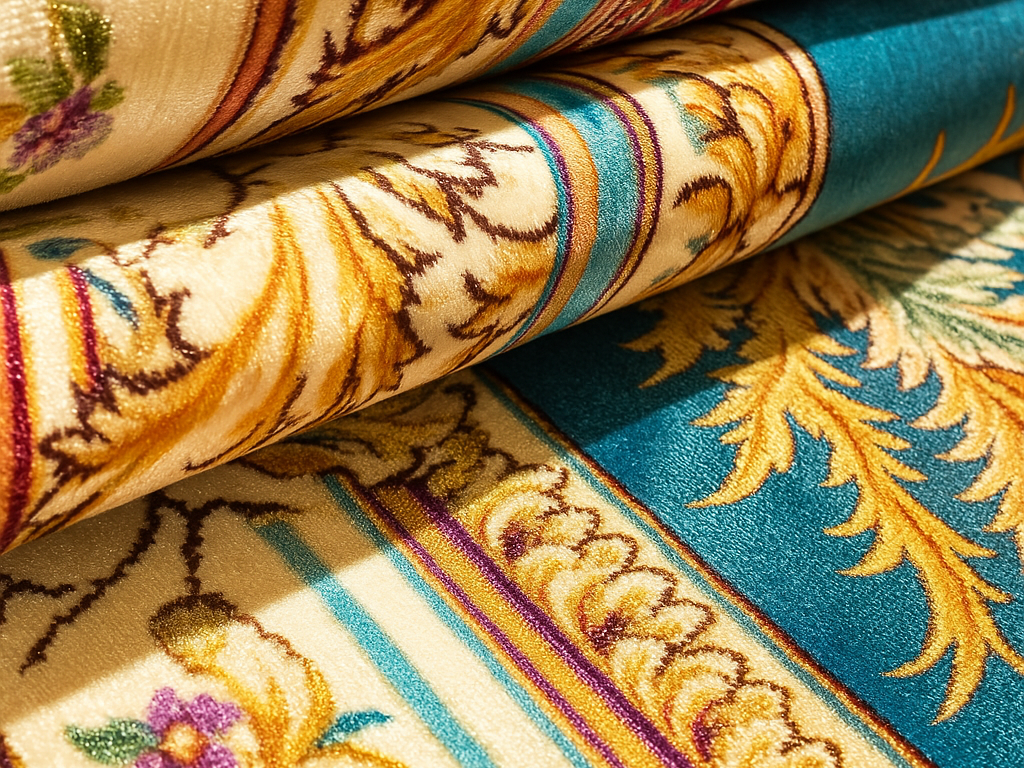Pasar de un gran vestíbulo a una acogedora habitación de invitados es algo más que cambiar de espacio: es un viaje cuidadosamente coreografiado que se transmite bajo sus pies. Transiciones de alfombras de hotel desempeñan un papel fundamental en esta experiencia, guiando a los huéspedes a través de sutiles cambios de color, textura y estampado, al tiempo que refuerzan tanto el flujo de diseño como la identidad de la marca. Si lo hace bien, creará una narración fluida que mejorará el confort, la acústica y el ambiente. Si se equivoca, corre el riesgo de alterar la sensación de calma o cohesión del huésped.
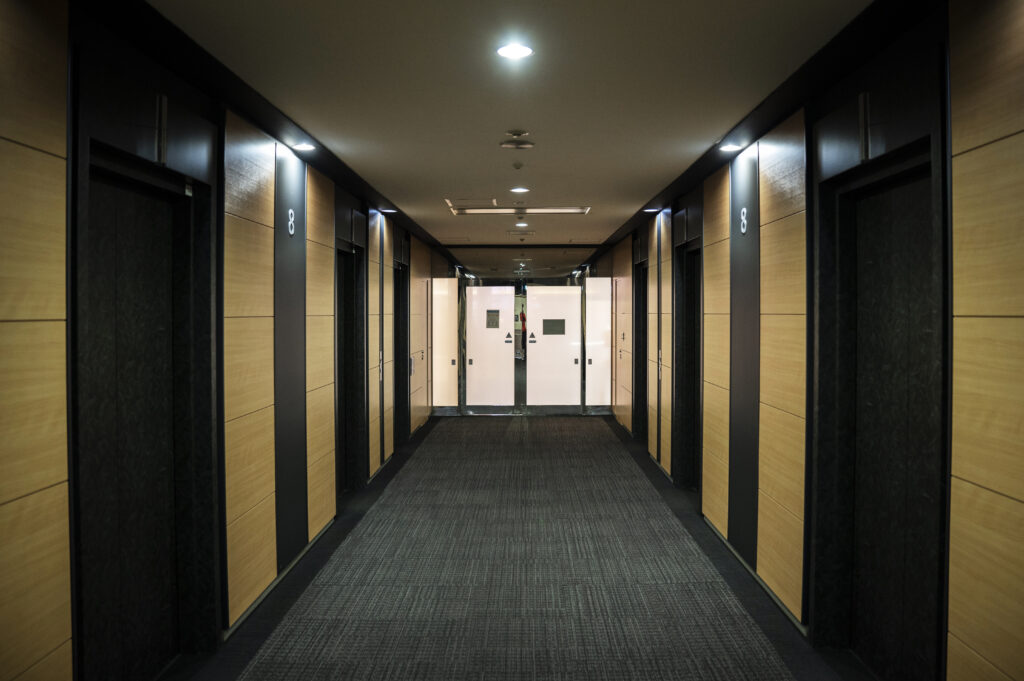
En este artículo, descubrirá cómo diseñar transiciones de moqueta que resulten intencionadas y armoniosas -desde el bullicioso vestíbulo hasta la serena suite- con estrategias prácticas, perspectivas sobre los retos clave y un vistazo a las tendencias más candentes de 2025. Tanto si se trata de escalar patrones, seleccionar fibras de alto rendimiento o especificar materiales ecológicos, esta guía cubre todo lo necesario para elevar el diseño de suelos en interiores de hostelería.
1. Introducción: Por qué son importantes las transiciones de alfombras
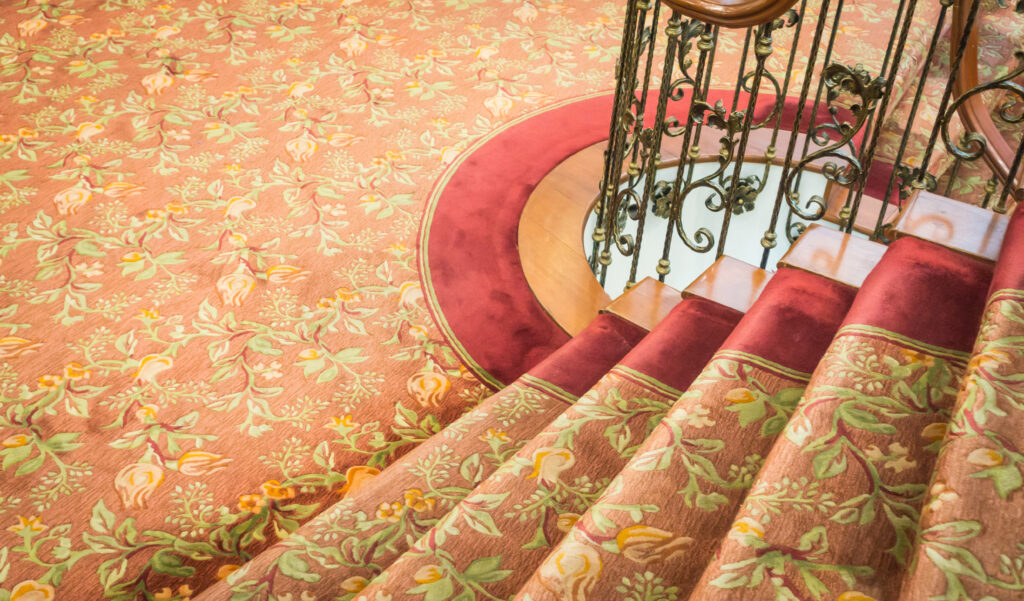
Todos los huéspedes de un hotel emprenden un viaje visual y táctil que comienza en el vestíbulo y termina en la intimidad de su habitación. Las transiciones entre alfombras no son triviales: comunican sutilmente seguridad, comodidad e intención de marca. Una transición mal gestionada -cambios bruscos de color, desajustes extraños de estampados- puede alterar la percepción del huésped y romper la inmersión. ¿Pero si se hace bien? El pasillo se convierte en un puente, no en una barrera, hacia la relajación.
2. El papel de la moqueta de hotel en el diseño
Las alfombras de hotel hacen mucho más que llenar un espacio. anclar la experiencia del huésped, fusionando función y forma de un modo que deleita tanto a la vista como al pie. Desglosémoslo:
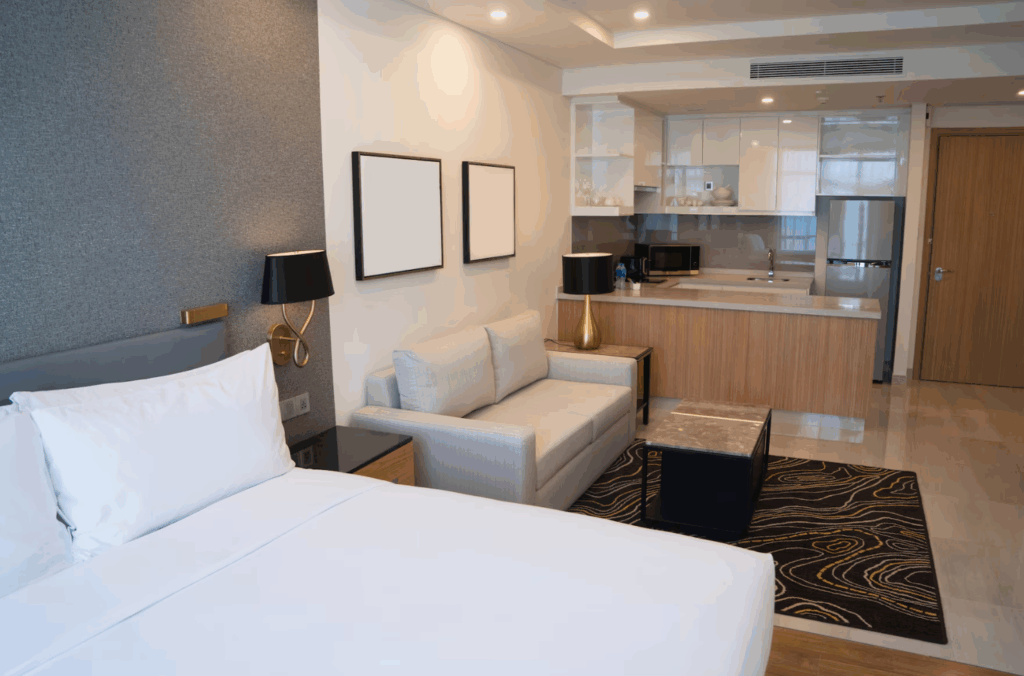
Confort acústico y control del ruido
Los hoteles son entornos bulliciosos por diseño, pero eso no significa que deban sonar como tales. Las moquetas, especialmente las de fibras densas y revestimientos especializados, absorben significativamente el ruido de los impactos y el parloteo, reduciendo el eco y el ruido de las pisadas. En vestíbulos y pasillos, esto hace que el ambiente general sea más relajado; en las habitaciones de los huéspedes, la absorción acústica es fundamental para la intimidad y el descanso ininterrumpido. Los estudios demuestran que los suelos enmoquetados pueden reducir el ruido de impacto hasta 30 decibelios en comparación con las superficies duras.
Confort bajo los pies y aislamiento térmico
Las alfombras suaves y afelpadas resultan acogedoras, sobre todo después de un día de viaje o reuniones. Amortiguan los pies y las articulaciones, haciendo que la estancia en un hotel sea físicamente más cómoda. Además de las ventajas táctiles, las moquetas actúan como aislantes naturales, manteniendo los espacios acogedores y reduciendo potencialmente las cargas de calefacción, ventilación y aire acondicionado. Por ejemplo, un suelo enmoquetado puede hacer que una habitación parezca más cálida aunque el termostato esté más bajo.
Impacto estético y de marca
Una alfombra cuidadosamente seleccionada hace algo más que parecer bonita: es habla. A través del color, el estampado, la textura y la escala, refuerza la marca y evoca emociones. Las geometrías atrevidas del vestíbulo pueden gritar ‘moderno y enérgico’; los ricos tonos joya de los pasillos susurran “elegancia y profundidad”; las texturas apagadas de las habitaciones sugieren paz y reposo. Los diseños personalizados -incluso con logotipos o motivos locales- son una gran oportunidad para reforzar la identidad de marca.
Zonificación y orientación espacial
Sin paredes ni señalización, la moqueta guía sutilmente a los huéspedes. Los cambios de diseño, color y textura pueden delimitar zonas (por ejemplo, asientos en el vestíbulo frente a pasillos para huéspedes) e incluso dirigir a los visitantes hacia los mostradores de recepción o los ascensores. Un motivo recurrente puede extenderse desde la entrada hasta el banco del ascensor, creando una sensación de viaje y propósito.
Durabilidad y seguridad
Las zonas muy transitadas de los hoteles exigen suelos resistentes a las manchas, que soporten un gran desgaste y sean ignífugos. Las moquetas modernas para hostelería utilizan fibras resistentes como el nailon y revestimientos antimanchas avanzados, que consiguen el equilibrio perfecto entre resistencia y atractivo visual. Además, sus superficies texturizadas ofrecen una mejor tracción para los pies, reduciendo el riesgo de resbalones, especialmente en zonas propensas a derrames.
Sostenibilidad y bienestar
En 2025, la responsabilidad medioambiental es fundamental. Muchos hoteles optan ahora por materiales de moqueta sostenibles -nilones reciclados, soportes con bajo contenido en COV o fibras biodegradables- que respaldan las certificaciones ecológicas. Más allá de los materiales respetuosos con el planeta, las moquetas con tratamientos antimicrobianos y el confort acústico contribuyen a unos interiores más saludables.
Lectura relacionada: Guía de alfombras para hoteles y hostelería 2025
3. Mapa del viaje: Vestíbulo → Pasillo → Habitación de invitados
Cada paso que da un huésped -desde la gran entrada del vestíbulo hasta el tranquilo refugio de su habitación- debe ser intencionado. Para trazar este recorrido, hay que entender el propósito y la atmósfera de cada zona y, a continuación, diseñar transiciones que fluyan tanto visual como experiencialmente.
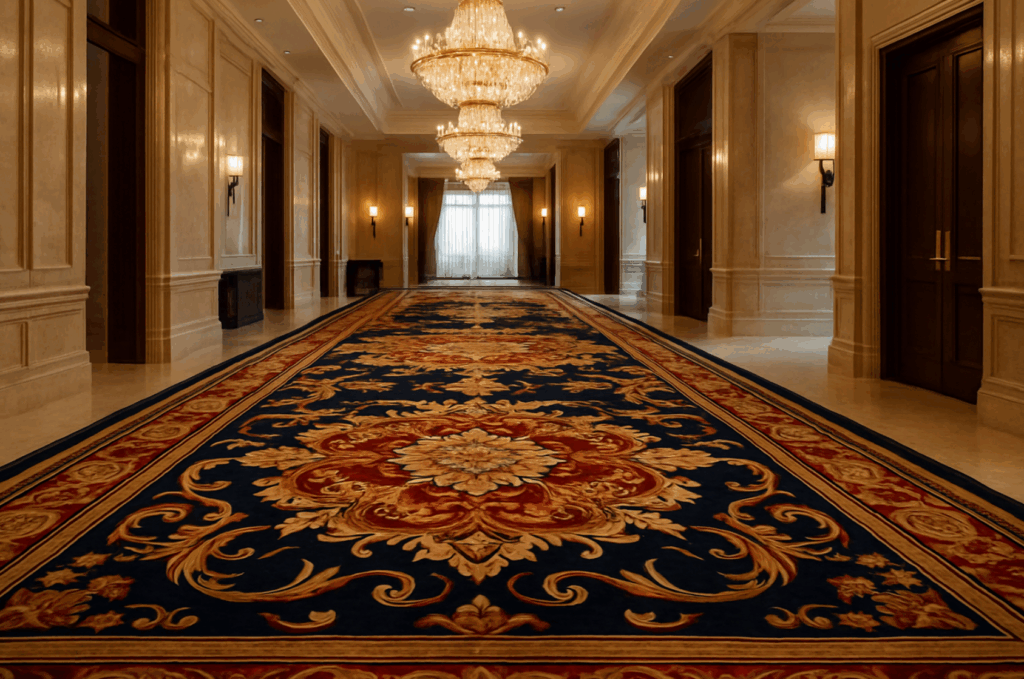
Vestíbulo: La primera impresión
El vestíbulo es la personalidad del hotel en acción: vibrante, dinámico, acogedor. Aquí, las alfombras son atrevidas y funcionales:
- Anclaje visual: Los motivos geográficos a gran escala, los motivos inspirados en la ciudad o los tonos de color de la marca sirven como anclas que transmiten identidad y establecen las expectativas de los visitantes.
- Alta durabilidad + resistencia a las manchas: Con un tráfico intenso, los vestíbulos requieren fibras resistentes, repelentes de manchas y un soporte ignífugo.
- Indicaciones de orientación: Sutiles señales en el suelo, como las pasarelas que conducen del mostrador de facturación a las zonas públicas, ayudan a guiar a los huéspedes sin necesidad de señalización explícita.
Como punto de entrada al viaje de un huésped, el suelo del vestíbulo debe impresionar y orientar al mismo tiempo.
Corredor: El Espacio Puente
Los pasillos plantean un reto de diseño: son muy transitados, pero deben ser tranquilos.
Ritmo y fluidez visuales
Siguiendo el manual de diseño electrónico de Hilton, las moquetas de los pasillos suelen presentar un “ritmo distintivo”, utilizando patrones repetitivos o variaciones en la caída de las guías (como las zonas de caída de las puertas) para evitar la monotonía. Estos patrones rítmicos forman una cadencia visual que indica progresión al tiempo que mantiene la continuidad. En los pasillos más largos, los nichos, las transiciones de iluminación y las demarcaciones del suelo rompen el efecto túnel y aumentan el interés.
Confort multisensorial
Las moquetas para pasillos absorben el eco y amortiguan las pisadas, manteniendo bajos los niveles de ruido. Esta amortiguación acústica ayuda a mantener la intimidad entre habitaciones y plantas. Con el tráfico concentrado en el centro, los bordes de acompañamiento también minimizan el desgaste y prolongan la vida útil.
Ecos de color y diseño
A menudo, las moquetas de los pasillos reflejan la paleta principal del vestíbulo -simplificada o desaturada- para crear una continuidad visual. Lydia Day, de Brintons Americas, subraya que el diseño de los pasillos es una ’extensión natural de la marca“, en la que la textura desempeña un papel clave frente a los motivos estridentes. Zeba World añade que las moquetas de los pasillos deben complementar el diseño del vestíbulo y las habitaciones, para garantizar transiciones fluidas.
Habitación de invitados: El destino final
La alfombra de la habitación de invitados es el clímax de la narrativa del suelo: personal, tranquila, reconfortante.
- Textura afelpada y acogedora: Las alfombras de pelo alto o de tacto lujoso crean aquí un contraste táctil con la superficie más firme del pasillo.
- Paleta apagada y motivos suaves: Las texturas tonales o los sutiles motivos orgánicos fomentan una atmósfera tranquila y reposada.
- Calor y aislamiento bajo los pies: Las alfombras retienen el calor y aumentan el confort térmico bajo los pies.
La zona acogedora es el punto de descanso final, la recompensa de diseño tras un viaje progresivo.
Zonas de transición: Cuando una zona se funde con otra
Tapas de final de pasillo y bajadas de puerta
En los puntos en los que los pasillos se encuentran con las habitaciones de invitados, los diseñadores suelen utilizar zonas de acento -moquetas que dejan caer la puerta, cambios de escala en el dibujo o cambios de pelo- para anunciar sutilmente las transiciones. Este truco rompe la monotonía de los “pasillos interminables” y marca la llegada a una habitación.
Escala y gradación de la paleta
Reduzca la escala de los motivos y desatura los colores a medida que avanza por las zonas. Por ejemplo, un elemento geográfico llamativo en el vestíbulo podría desvanecerse en una versión a menor escala o monocromática en los pasillos, y convertirse en una textura casi pura en las habitaciones. Esta estratificación visual mantiene la cohesión a la vez que cambia el tono.
Cambio de material
Utilice moquetas duraderas de pelo fino en las zonas públicas y, a continuación, alfombras de felpa en las habitaciones. Huéspedes siente este cambio significativamente-señala que han llegado a su retiro personal.
Lectura relacionada: Cómo elegir alfombras para hoteles
4. Estrategias de diseño para transiciones fluidas
Lograr transiciones de moqueta visual y experiencialmente suaves entre las zonas del hotel no consiste sólo en combinar colores, sino en una matizada estratificación de patrones, texturas, señalización y estrategia de materiales. He aquí cómo lo consiguen los mejores diseñadores hoteleros:
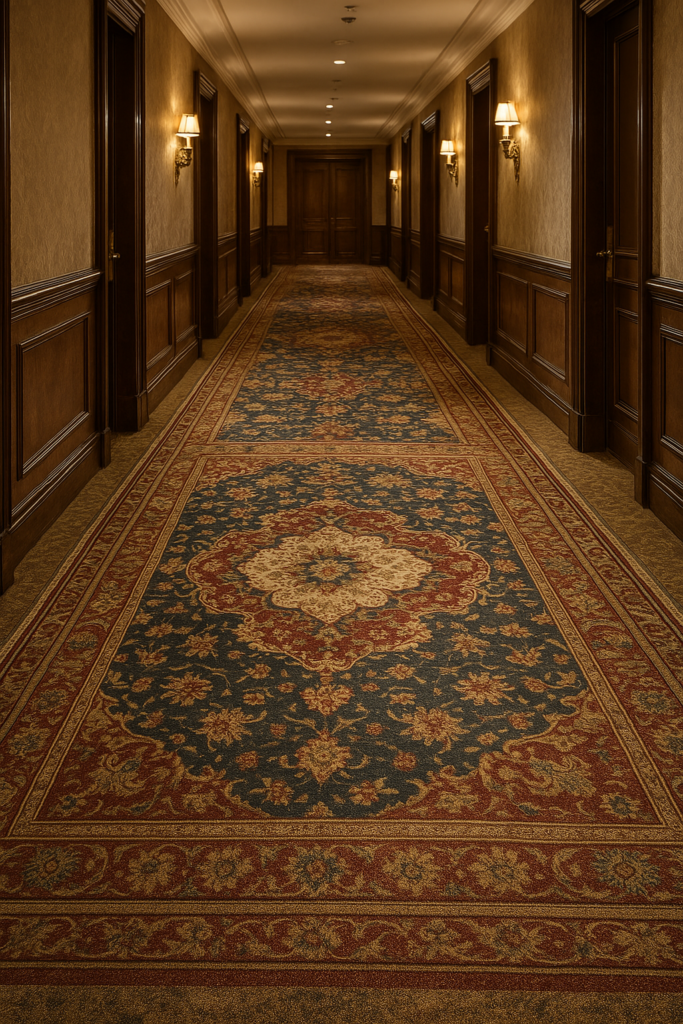
Color cohesivo y cambios de paleta
Empieza audaz, luego se suaviza. Una paleta vibrante en el vestíbulo debe desvanecerse suavemente en tonos complementarios por el pasillo y en tonos tranquilos en las habitaciones. Esta desaturación gradual guía a los huéspedes al tiempo que mantiene la identidad de la marca. Los diseñadores utilizan ecos de color en las intersecciones -como un acento en el pasillo que se inspira en los patrones del vestíbulo- para facilitar el cambio visual.
Escala de patrones y ritmo
Hazte eco del patrón, ajusta la escala. En los vestíbulos, los diseñadores pueden elegir motivos geométricos grandes y expresivos. Los pasillos presentan una repetición simplificada o más ajustada de ese motivo, mientras que las habitaciones presentan referencias tonales y texturales en lugar de estampados llamativos. Así se crea un linaje de diseño sin fisuras. Hilton hace hincapié en mantener el ritmo visual a lo largo de los pasillos, marcando el camino con acentos de entrada que rompan la posible monotonía.
Variación de textura y pelo
Deja que los pies sientan la transición. Las duraderas moquetas de bucle en zonas de mucho tránsito se transforman en cortes de felpa en las habitaciones. Esta evolución táctil -firme al pisar en las zonas públicas, suave en las privadas- facilita la orientación y refuerza el recorrido. Además, las texturas de las superficies pueden cambiar sutilmente de pendiente o altura para delimitar zonas sin bordes visibles.
Señalización con patrones de suelo
Las alfombras como señales de dirección. Los motivos serpenteantes o “corredores” incrustados en las alfombras pueden guiar a los invitados hacia los ascensores o las zonas de descanso. Por ejemplo, Ege Carpets destaca el uso de caminos hexagonales en las zonas de pre-funcionamiento para orientar el tráfico hacia los espacios de eventos. Los diseños de pasillos también ayudan a orientar y romper la repetición.
Acentos para puertas e intersecciones
Marca los umbrales. En la entrada de cada habitación de invitados, utilice zonas de caída de puertas -secciones más pequeñas, con colores de acento o texturas- para señalar dónde se dividen los caminos. Esta estrategia acentúa la fluidez de los pasillos y ayuda a evitar la desorientación inducida por la uniformidad. En los vestíbulos de los ascensores, los diseñadores pueden ampliar o intensificar los motivos de los pasillos para crear un momento de pausa visual.
Suelo técnico sin juntas frente a baldosas
Minimice las costuras, maximice la continuidad. La moqueta en rollo -especialmente las de grandes diseños repetitivos- puede atravesar a la perfección estancias públicas y privadas. Esta tendencia es popular en hoteles de lujo para reducir el desorden visual y el desperdicio de material. Los diseñadores de Encore Hospitality Carpet informan de un cambio hacia moquetas asimétricas y unificadas en lugar de sistemas separados de pasillo/puerta.
Capas de material y rendimiento
Ajustar la fibra a la necesidad de la zona. Las zonas públicas suelen utilizar nylon resistente a las manchas o mezclas de lana y nylon con respaldo comercial para seguridad contra incendios (ASTM I/II) y tráfico intenso. En las habitaciones de huéspedes se opta por mezclas sintéticas más suaves u opciones ricas en lana para ofrecer lujo y confort, al tiempo que durabilidad y fácil mantenimiento.
Sostenibilidad, bienestar y armonía acústica
Combinar diseño y bienestar. Las moquetas respetuosas con el medio ambiente -nylon reciclado, soportes con bajo contenido en COV, acabados antimicrobianos- son ahora un elemento básico. Los pasillos deben tener un soporte acústico para amortiguar el ruido, mientras que las texturas afelpadas de las habitaciones aumentan el confort térmico y la calma psicológica.
Tejidos y marcas digitales personalizados
Haz de la alfombra un lienzo de cuentos. Con el tejido digital, los hoteles pueden entretejer logotipos, puntos de referencia locales o colores de marca en los motivos de sus alfombras. Estos diseños pueden escalarse de forma natural por zonas: vivos en los vestíbulos, simplificados en los pasillos y tenues en las habitaciones, reforzando la identidad sin distracciones.
10 Integración sin fronteras con suelos adyacentes
Conectar los materiales con la gracia. En espacios que mezclan moqueta con superficies más duras -como las zonas de vestíbulo a restaurante-, las bandas de transición o los perfiles reductores garantizan la seguridad al tiempo que favorecen el flujo visual. Minimizar los cambios bruscos preserva la inmersión.
Lectura relacionada: Guía definitiva de tipos de alfombras: Materiales, tejidos y ajuste interior
5. Desafíos en el diseño de alfombras de hotel
Diseñar moquetas que tengan un aspecto impresionante y un rendimiento fiable en los hoteles no es tarea fácil. Desde las exigencias de durabilidad hasta los obstáculos de mantenimiento, estos son los principales retos que deben superar los diseñadores y operadores, cada uno de ellos basado en experiencias reales de hoteles y respaldado por conocimientos del sector.
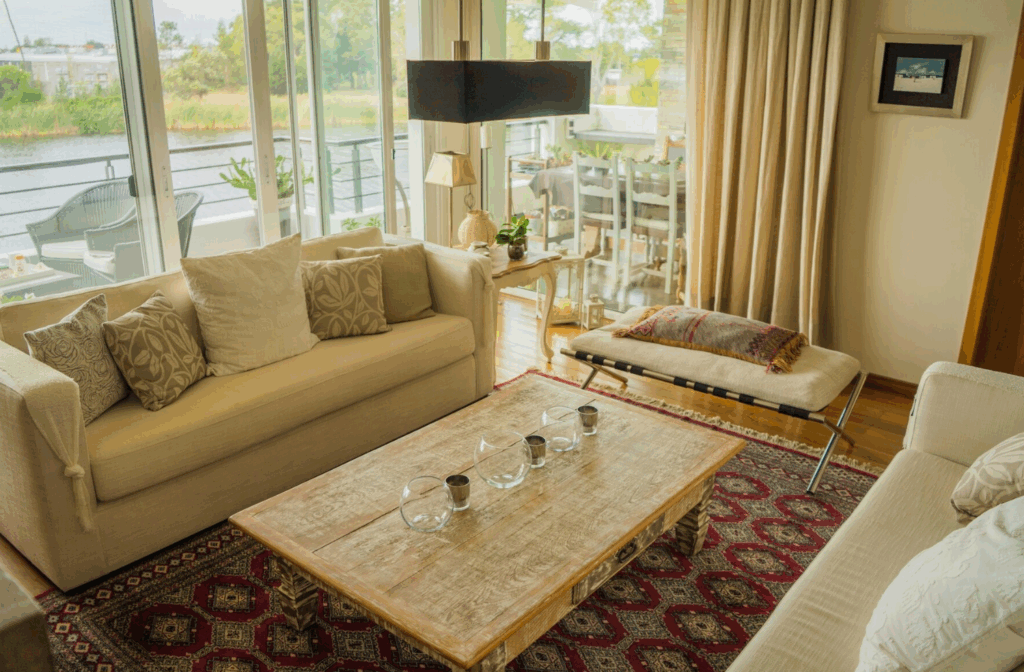
- Equilibrio entre durabilidad y comodidad: Las zonas de mucho tránsito exigen fibras resistentes, antimanchas e ignífugas (ASTM 648/NFPA 253). Pero los huéspedes anhelan suavidad en sus habitaciones: encontrar el punto óptimo no es fácil.
- Coste y residuos: Las zonas de moqueta inconexas implican más costuras, más residuos. La estrategia de un patrón transversal simplifica la adquisición, reduce el desperdicio de bordes y recorta los costes.
- Mantenimiento y prevención de manchas: Los pasillos se enfrentan a rozaduras, salpicaduras, botas. Las alfombras necesitan acabados protectores. Las habitaciones, por su parte, deben ser frescas, sobre todo las de lujo.
- Coordinación con otros elementos de diseño: Las alfombras no existen solas. La iluminación, las obras de arte y el mobiliario deben armonizar con las transiciones de las alfombras; de lo contrario, se rompe la narrativa.
Lectura relacionada: Alfombras anudadas a mano: Diferencias clave que todo comprador debe conocer
6. Nuevas tendencias e innovaciones (2025)
A medida que nos adentramos en 2025, el diseño de las alfombras de los hoteles está evolucionando más allá de la funcionalidad básica, hacia experiencias inmersivas, sostenibles y tecnológicas. He aquí un resumen de las tendencias más significativas que están cambiando el panorama:
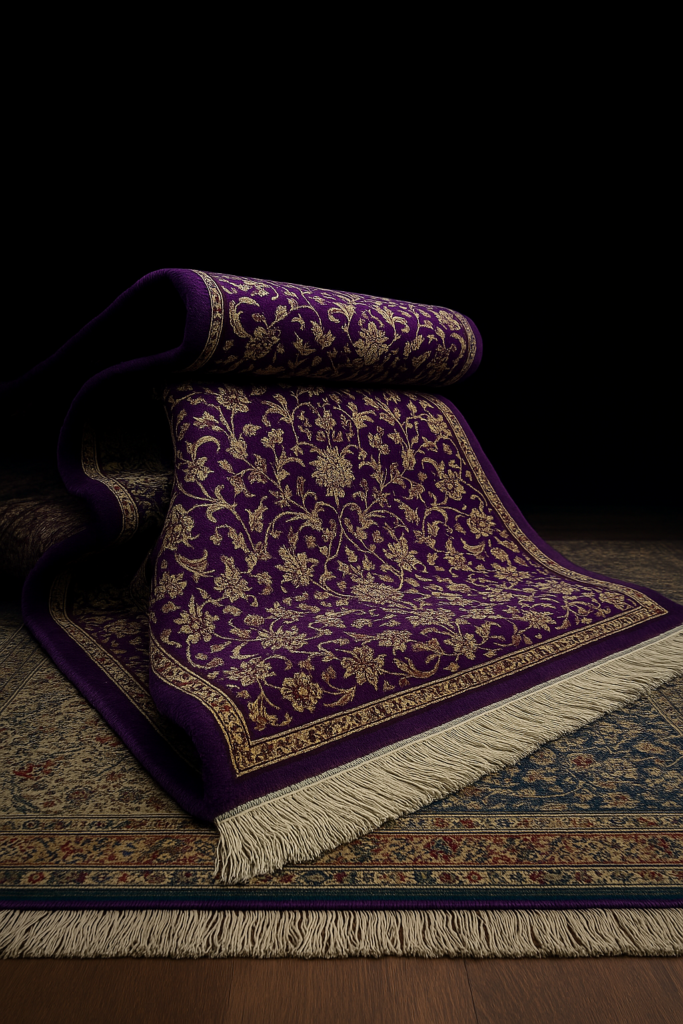
Materiales sostenibles, reciclados y regeneradores 🌍
- Fibras reutilizadas y de bajo impacto: Marcas como Zeba World lideran el cambio hacia moquetas fabricadas con fibras recicladas y sostenibles que mantienen el rendimiento y el atractivo visual, una demanda creciente en el diseño de hostelería este año.
- Lana biodegradable y de origen responsable: Alrededor de 70% de las nuevas líneas de moquetas sintéticas contienen ahora contenido reciclado, y la certificación se centra más en el bienestar animal y la trazabilidad de la cadena de suministro.
- Fabricación respetuosa con el medio ambiente: Entre las técnicas empleadas figuran el teñido con poca agua, el PET reciclado, las redes de pesca reutilizadas y los plásticos postconsumo, que cumplen tanto los requisitos de la certificación verde como las expectativas de los huéspedes ecológicos.
Estilos atrevidos, texturizados y maximalistas
- Patrones llamativos: La geometría vibrante, los motivos abstractos y los colores llamativos, antes poco frecuentes en la hostelería, se adoptan ahora en vestíbulos y espacios sociales.
- Tejidos en capas: Las alturas y texturas multipelo introducen profundidad bajo los pies, resonando con atmósferas biofílicas y orientadas al bienestar.
- Renacimiento maximalista: El regreso de las alfombras de pared a pared con atrevidos elementos visuales refleja una creciente preferencia por la calidez y la nostalgia en los espacios interiores.
Innovación acústica y bienestar
- Diseños con respaldo acústico: Las moquetas están cada vez más diseñadas para controlar el ruido, algo esencial en espacios abiertos, zonas de coworking y hoteles de varias plantas.
- Influencias biofílicasLa HD Expo de 2024 presentó colecciones inspiradas en la naturaleza y orientadas al bienestar, como las alfombras de Milliken con temática acuática y la gama ReBloom de Mohawk, neutra en emisiones de carbono.
Tejidos inteligentes, digitales y personalizados
- Impresión digital y mechón de precisión: La producción avanzada permite crear motivos personalizados nítidos -logos, mapas, temas de marca- que se escalan por zonas sin disonancia visual.
- Alfombras con tecnología mejorada: Los nuevos sistemas de suelos “inteligentes” utilizan fibras conductoras o sensores para seguir el tráfico peatonal o detectar caídas, una innovación con visión de futuro para la seguridad y las operaciones.
Sistemas híbridos de moqueta y baldosas modulares
- Aplicaciones de telas anchas sin costuras: Los hoteles están optando por alfombras unificadas que abarcan zonas públicas y privadas, lo que reduce las costuras, los residuos y el tiempo de instalación.
- Ventajas de las baldosas modulares: Las losetas de moqueta ofrecen flexibilidad de diseño, facilidad de sustitución y reducción de residuos (1-3% frente a 5-25% de la moqueta en rollo), a la vez que admiten diseños atrevidos y acentos específicos para cada habitación.
Adaptación regional y cultural
- Paletas de diseño localizadas: La elección de colores y motivos se está adaptando geográficamente: azules terrosos en los hoteles costeros, estampados intrincados en los de Oriente Medio y durabilidad sintética en los de Asia-Pacífico.
- Relatos culturales: Los hoteles boutique y de estilo de vida incorporan la cultura local al diseño de las alfombras, ya sea a través de estampados, texturas o combinaciones de colores específicas de la región.
Lectura relacionada: Tendencias de color en alfombras de pelo insertado: Lo que está de moda en 2025
7. Guía de aplicación: Del concepto a la pasarela
Dar vida a su visión de diseño de transiciones de moqueta perfectas implica algo más que elegir diseños: requiere una planificación meticulosa, una coordinación experta y una instalación precisa. He aquí una refinada hoja de ruta:
Planificación del proyecto y evaluación del emplazamiento
- Mapa de zonas: Empiece por analizar todas las zonas -vestíbulo, pasillo, habitaciones- teniendo en cuenta el tráfico peatonal, la acústica, la orientación y los factores ambientales.
- Inspección in situ: Antes de nada, inspeccione los subsuelos. Deben estar limpios, secos, nivelados y estructuralmente firmes, con pruebas de humedad y pH según las normas ASTM o locales.
- Aclimatación: Los materiales de moqueta deben desembalarse y aclimatarse en el entorno de instalación durante al menos 24-48 horas (más tiempo en los meses más fríos).
Diseño y especificaciones técnicas
- Paleta maestra y plan de motivos: Definir la jerarquía: diseño audaz del vestíbulo, ecos a escala de los pasillos y acabados tonales o texturales de las estancias, garantizando transiciones visuales y táctiles suaves.
- Selección de material por zonas: Especifique mezclas duraderas de nailon para los espacios públicos, alfombras de felpa de pelo largo (o mezclas ricas en lana) en las habitaciones. Garantice el cumplimiento de las normas de seguridad contra incendios (ASTM E648/NFPA 253 o EN 1307).
- Estrategia de corte y costura: Planifique la disposición del rollo para que el patrón coincida, la colocación de la costura y el desperdicio sean mínimos.
Preparación del subsuelo y del almacén
- Pruebas de humedad y alcalinidad: Utilice los protocolos ASTM F2170 o F1869-emisión de humedad ≤ 5 lbs/1000 ft²/día o humedad relativa ≤ 85%.
- Condiciones de almacenamiento: Almacenar los rollos en estanterías planas, de dos alturas como máximo, en un ambiente sellado y de temperatura controlada (idealmente 65-95 °F; 40-70 % HR).
Métodos de instalación
- Stretch-in: Ideal para zonas que necesitan amortiguación bajo los pies y flexibilidad. Utilice estiradores eléctricos para una cobertura limpia y sin arrugas y una cinta de costura duradera.
- Pegamento doble: Utilice adhesivo para el respaldo del cojín y la moqueta en zonas públicas muy transitadas, garantizando una fuerte adherencia para una larga duración.
- Pegamento directo: El más adecuado para las transiciones de suelo encolado, especialmente cuando hay calefacción por suelo radiante.
- Baldosas modulares: Útil en pasillos o áreas de servicio; ofrece una fácil sustitución y un desperdicio mínimo. Se instala en forma de tablero de ajedrez o lineal, totalmente pegado o adhesivado.
Combinación de costuras y patrones
- Alineación de patrones: Haga coincidir los motivos a través de las costuras; la secuenciación del rollo, el arco del patrón, el arqueo y la corrección de la inclinación son importantes para la armonía visual.
- Sellado de costuras: Aplique sellador de costuras en los bordes cortados antes de unir para evitar que se deshaga. Utilice cinta termofusible donde se especifique y, a continuación, pase el rodillo con el peso adecuado para la adhesión.
Acabado y control de calidad
- Recorte y detalles de los bordes: Recorte cuidadosamente hasta las paredes, puertas y umbrales; instale bandas de transición entre distintos tipos de suelo.
- Laminado final y limpieza: Utilice rodillos de púas o de tambor en baldosas modulares; las instalaciones de suelo ancho se benefician de rodillos de escoba o glyda. Evite el tránsito peatonal hasta que se sequen los adhesivos (a menudo entre 24 y 48 horas).
- Inspección: Realice un recorrido para comprobar si hay arrugas, costuras visibles, desajustes de patrones y defectos de material.
Cuidados y mantenimiento tras la instalación
- Atención inicial: Después de la instalación, aspire y cepille el pelo. Organice una limpieza profesional (encapsulado de baja humedad o extracción con agua caliente) en un plazo de 6 a 12 meses en función del tráfico. .
- Programa en curso: Definir rutinas de aspirado diario, tratamiento de manchas, limpieza en profundidad e inspección para preservar el aspecto y la longevidad.
8. Conclusión
Las transiciones de moqueta cuidadosamente diseñadas hacen algo más que conectar habitaciones: dan forma a los viajes de los huéspedes, refuerzan la identidad de la marca y aumentan el confort. En 2025, esto significa adoptar un diseño atrevido, bienestar acústico, sostenibilidad y personalización digital. Hechas con intención, las moquetas son los narradores silenciosos de un hotel, suelos que hablan a cada paso.
9. Preguntas frecuentes
P1: ¿Por qué no utilizar suelo duro en todo el edificio?
Las alfombras reducen el ruido, son cómodas, antideslizantes y ahorran energía. Las superficies duras pueden resultar frías y producir eco.
P2: ¿Las transiciones entre alfombras ralentizan a los huéspedes?
No si está bien diseñado. Los cambios graduales en el patrón calman a los huéspedes en lugar de asustarlos y empujarlos hacia delante.
P3: ¿Son más caras las alfombras sostenibles?
Inicialmente sí, pero ofrecen ahorros a largo plazo gracias a su longevidad, eficiencia energética y valor de marca.
P4: ¿Con qué frecuencia deben sustituirse las moquetas de los pasillos?
Normalmente cada 7-10 años, dependiendo del desgaste. Un mantenimiento regular puede prolongar la vida útil.
P5: ¿Se pueden tejer logotipos o marcas en la moqueta?
Sí: las moquetas de tejido digital permiten personalizar gráficos y marcas que pueden repetirse sutilmente por zonas.

